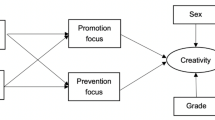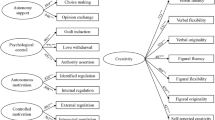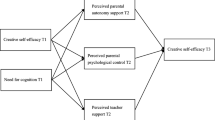Abstract
Many parents nowadays want to know how they can foster their offspring’s creativity. The aim of this chapter is to review the literature on climate for creativity in the family context and introduce a new instrument. The Climate for Creativity in Parent-Child Relationship Questionnaire is constructed to measure and diagnose parental behaviors which may either stimulate or block a child’s creative development. Firstly, a wide range of research on the climate for creativity, particularly in the home environment, is discussed. Secondly, the characteristics, construction procedure as well as the CCP-CRQ’s psychometrical properties are described. Finally, the potential areas of application in research and psychological practice are presented.
Access this chapter
Tax calculation will be finalised at checkout
Purchases are for personal use only
Similar content being viewed by others
References
Albert, R. S. (1971). Cognitive development and parental loss among the gifted, the exceptionally gifted, and the creative. Psychological Reports, 29, 19–26.
Albert, R. S. (1980). Family position and the attainment of eminence: A study of special family positions and special family experience. In R. S. Runco (Ed.), Genius and eminence (pp. 141–154). New York: Oxford University Press.
Albert, R. S. (1994). In N. Colangelo & S. Assouline (Eds.)., Talent development The contribution of early family history to the achievement of eminence (pp. 311–360). Dayton, OH: Ohio Psychology Press.
Albert, R. S., & Runco, M. A. (1986). The achievement of eminence: A model based on a longitudinal study of exceptionally gifted boys and their families. In R. J. Sternberg & J. E. Davidson (Eds.), Conceptions of giftedness (pp. 332–360). Cambridge, UK: Cambridge University Press.
Amabile, T. M. (1983). The social psychology of creativity. New York: Springer.
Amabile, T. M. (1989). Growing up creative: Nurturing a lifetime of creativity. New York: Crown.
Amabile, T. M. (1996). Creativity in context. Boulder, CO: Westview Press Inc.
Amabile, T. M., Burnside, R. M., & Gryskiewicz, S. S. (1995). Technical manual for KEYS: Assessing the climate for creativity. Greensbor, NC: Centre for Creative Leadership.
Bloom, B. S. (Ed.). (1985). Developing talent in young people. New York: Ballantine Books.
Bloom, B. S., & Sosniak, L. A. (1981). Talent development. Educational Leadership, 39(2), 86–94.
Brown, S. P., & Leigh, T. W. (1996). A new look at psychological climate and its relationship to job involvement, effort, and performance. Journal of Applied Psychology, 81(4), 358–368.
Colangelo, N. (1988). Families of gifted children: The next ten years. Roeper Review, 11, 16–18.
Csikszentmihályi, M. (1996). Creativity: Flow and the psychology of discovery and invention. New York: HarperCollins Publishers.
Csikszentmihályi, M. (1999). Implications of a systems perspective for the study of creativity. In R. J. Sternberg (Ed.), Handbook of creativity (pp. 313–335). Cambridge, UK: Cambridge University Press.
Dacey, J. S. (1989). Discriminating characteristics of the families of highly creative adolescents. Journal of Creative Behavior, 23(4), 263–271.
Dalton, W., Frick-Horbury, D., & Kitzmann, K. (2006). Young adults’ retrospective reports of parenting by mothers and fathers: Associations with current relationship quality. Journal of General Psychology, 133(1), 5–18.
Domino, G. (1969). Maternal personality correlates of sons’ creativity. Journal of Consulting and Clinical Psychology, 30, 150–154.
Ekvall, G. (1999). Creative climate. In M. A. Runco & S. R. Pritzker (Eds.), Encyclopedia of creativity (Vol. I, pp. 403–413). New York: Academic Press.
Foster, L. (2004). Early influences on creativity in great Britain. In M. Fryer (Ed.), Creativity and cultural diversity (pp. 131–136). Leeds: The Creativity Centre Educational Trust.
Freinerg, H. J. (1999). School climate: Measuring, improving and sustaining healthy learning environments. Philadelphia: Falmer Press.
Gardner, H. (1993). Frames of mind: The theory of multiple intelligences (10 anniversary ed.). New York: Basic Books.
Goertzel, M. G., Goertzel, V., & Goertzel, T. G. (1978). 300 eminent personalities. San Francisco: Jossey-Bass.
Goertzel, V., Goertzel, M. G., Goertzel, T. G., & Hansen, A. (2004). Cradles of eminence: Childhoods of more than 700 famous men and women. Scottsdale, AZ: Great Potential Press, Inc.
Gough, H. G. (1975). The California Psychological Inventory. Palo Alto, CA: Consulting Psychologists Press.
Grant, T. N. (1973). A study of masculinity-femininity in creative male adolescents and their parents (Doctoral disserta-tion, Fordham University, 1972). Dissertation Abstracts International, 33(4), 3304B.
Griffith, J. (1999). School climate as “social order” and “social action”: A multi-level analysis of public elementary school student perceptions. Social Psychology of Education, 2, 339–369.
Gute, G., Gute, D. S., Nakamura, J., & Csikszentmihályi, M. (2008). The early lives of highly creative persons: The influence of the complex family. Creativity Research Journal, 20(4), 343–357.
Hancock, G. R., & Mueller, R. O. (2001). Rethinking construct reliability within latent variable systems. In R. Cudeck, S. du Toit, & D. Srbom (Eds.), Structural equation modeling: Present and future—festschrift in honor of Karl Jöreskog (pp. 195–216). Lincolnwood, IL: Scientific Software International. Inc.
Harrington, D. M., Block, J. H., & Block, J. (1987). Testing aspects of Carl Rogers’s theory of creative environments: Child-rearing antecedents of creative potential in young adolescents. Journal of Personality and Social Psychology, 52(4), 851.
Helson, R. (1968). Effects of sibling characteristics and parental values on creative interest and achievement. Journal of Personality, 36, 589–607.
Hunter, S. T., Bedell, K. E., & Mumford, M. D. (2007). Climate for creativity: A quantitative review. Creativity Research Journal, 19, 69–90.
Isaksen, S. G., & Lauer, K. J. (2002). The climate for creativity and change in teams. Creativity and Innovation Management, 11(1), 74–86.
Isaksen, S. G., Lauer, K. J., & Ekvall, G. (1999). Situational outlook questionnaire: A measure of the climate for creativity and change. Psychological Reports, 85, 665–674.
Isaksen, S. G., Lauer, K. J., Ekvall, G., & Britz, A. (2000–2001). Perceptions of the best and worst climates for creativity: Preliminary validation evidence for situational outlook questionnaire. Creativity Research Journal, 2, 171–184.
James, L. A., & James, L. R. (1989). Integrating work environment perceptions: Explorations into the measurement of meaning. Journal of Applied Psychology, 74, 739–751.
James, L. R., Hater, J. J., Gent, M. J., & Bruni, J. R. (1978). Psychological climate: Implications from cognitive social learning theory and interactional psychology. Personnel Psychology, 31, 783–813.
James, L. R., James, L. A., & Ashe, D. K. (1990). The meaning of organizations: The role of cognition and values. In B. Schneider (Ed.), Organizational climate and culture (pp. 41–84). San Francisco: Jossey-Bass.
James, L. R., & Jones, A. P. (1974). Organizational climate: A review of theory and research. Psychological Bulletin, 81, 1096–1112.
Karwowski, M., Lebuda, I., Wiśniewska, E., & Gralewski, J. (2013). Big five personality factors as the predictors of creative self-efficacy and creative personal identity: Does gender matter. The Journal of Creative Behavior, 47(3), 215–232.
Kaufman, J. C., & Beghetto, R. A. (2009). Beyond big and little: The four c model of creativity. Review of General Psychology, 13(1), 1–12. https://doi.org/10.1037/a0013688.
Kwaśniewska, J., & Nęcka, E. (2004). Perception of the climate for creativity in the workplace: The role of the level in the organization and gender. Creativity and Innovation Management, 2(13), 187–196.
Kwaśniewska, J. M., Gralewski, J., Witkowska, E., Kostrzewska, M., & Lebuda, I. (2018). Mothers’ personality traits and the climate for creativity they build with their children. Thinking Skills and Creativity, 27, 13–24.
Kwaśniewska, J. M., & Lebuda, I. (2017). Balancing between the roles and duties – Creativity of mothers. Creativity. Theories – Research – Applications, 4(1), 137–158.
MacKinnon, D. W. (1962). The nature and nurture of creative talent. American Psychologist, 17(7), 484–495.
McConnell, S. R., Priest, J. S., Davis, S. D., & McEvoy, M. A. (2002). Best practices in measuring growth and development for preschool children. In A. Thomas & J. Grimes (Eds.), Best practices in school psychology (4th ed., pp. 1231–1246). Washington, DC: National Association of School Psychologists.
McCurdy, H. G. (1960). The childhood pattern of genius. Horizon, 2, 33–38.
Mellou, E. (1996). The two-conditions view of creativity. The Journal of Creative Behavior, 30, 126–143.
Michel, M., & Dudek, S. Z. (1991). Mother-child relationships and creativity. Creativity Research Journal, 4(3), 281–286.
Milgram, R. M., & Hong, E. (1999). Creative out-of-school activities in intellectually gifted adolescents as predictors of their life accomplishment in young adults: A longitudinal study. Creativity Research Journal, 12, 77–87.
Miller, A. L., Lambert, A. D., & Neumeister, K. L. S. (2012). Parenting style, perfectionism, and creativity in high-ability and high-achieving young adults. Journal for the Education of the Gifted, 35(4), 344–365.
Miller, B. C., & Gerard, D. (1979). Family influences on the development of creativity in children: An integrative review. Family Coordinator, 28, 295–312.
Nęcka, E., & Kwaśniewska, J. (2005). Climate for creativity in Polish companies: Does a new market economy need new ideas? In W. B. Jostingmeier & H. J. Boeddrich (Eds.), 8th European Conference on Creativity and Innovation – Conference Proceedings Book (pp. 237–259). Mainz: Deutsche Universitas Verlag.
Nichols, R. C. (1964). Parental attitudes of mothers of intelligent adolescents and creativity of their children. Child Development, 35, 1041–1049.
Niedziałek, A. & Kwaśniewska, J. M. (in preparation). Climate for Creativity in Parent-Child Relationship in the Perception of Mothers and Fathers. Creativity Theories – Research – Applications.
Orinstein, A. S. (1961). An investigation of parental child-rearing attitudesand creativity in children (Doctoral dissertation, University of Denver, 1961). Dissertation Abstracts Inter-national, 22, 4085–5086.
Parker, C. P., Baltes, B. B., Young, S. A., Huff, J. W., Altmann, R. A., Lacost, H. A., & Roberts, J. E. (2003). Relationships between psychological climate perceptions and work outcomes: A meta-analytic review. Journal of Organizational Behavior, 24, 389–416.
Plucker, J. A. (1998). Beware of simple conclusions: The case for content generality of creativity. Creativity Research Journal, 11, 179–182.
Puccio, M. Mance, M. C. Murdock, B. Miller, J. Vehar, R. Firestien, S. Thurber, & D. Nielsen. (2011). Educating for creativity. Level 1. Resource book. Creative Education Foundation.
Richards, R. (1990). Everyday creativity, eminent creativity, and health: “Afterview” for CRJ issues on creativity and health. Creativity Research Journal, 3, 300–326.
Robinson, C. C., Mandleco, B., Olsen, S. F., & Hart, C. H. (1995). Authoritative, authoritarian and permissive parenting practices: Development of a new measure. Psychological Reports, 77, 819–830.
Robinson, C. C., Mandleco, B., Olsen, S. F., & Hart, C. H. (2001). The parenting styles and dimension Questionnaire (PSDQ). In B. F. Perlmutter, J. Touliatos, & G. W. Holden (Eds.), Handbook of family measurement techniques: Vol. 3. Instruments & index. Thousand Oaks, CA: Sage.
Rousseau, D. M. (1988). The construction of climate in organizational research. In W. L. C. Cooper & I. T. Robertson (Eds.), International review of industrial and organizational psychology (pp. 139–158). Oxford, UK: John Wiley & Sons.
Runco, M. A. (2007). Creativity. Theories and themes: Research, development, and practice. Oxford: Elsevier Inc.
Runco, M. A., & Albert, R. S. (1985). The reliability and validity of ideational originality in the divergent thinking of academically gifted and nongifted children. Educational and Psychological Measurement, 45(3), 483–501.
Runco, M. A., & Albert, R. S. (2005). Parents’ personality and the creative potential of exceptionally gifted boys. Creativity Research Journal, 17(4), 355–367.
Schneider, B. (2002). Climate strength: A new direction for climate research. Journal of Applied Psychology, 87(2), 220–229.
Schneider, B., & Bowen, D. (1995). Winning the service game. Boston: Harvard Business School Press.
Schneider, S. H., & Duran, L. (2010). School climate in middle schools: A cultural perspective. Journal of Research in Character Education, 8, 25–37.
Schultz, D. P., & Schultz, S. E. (2016). A history of modern psychology (11th ed.). Boston: Cengage Learning.
Stein, M. I. (1953). Creativity and culture. Journal of Psychology, 36, 311–322.
Tennent, L., & Berthelsen, D. (1997). Creativity: What does it mean in the family context? Journal of Australian Research in Early Childhood Education, 1, 91–104.
van Houte, M. (2005). Climate or culture? A plea for conceptual clarity in school effectiveness research. School Effectiveness and School Improvement, 16(1), 71–89.
Walberg, H. J. (1981). Childhood traits and environments of highly eminent adults. The Gifted Child Quarterly, 25, 103–107.
Walberg, H. J., Zhang, G., Cummings, C., Fillipelli, L. A., Freeman, K. A., Haller, E. P., et al. (1996). Childhood traits and experiences of eminent women. Creativity Research Journal, 9(1), 97–102.
Wang, M. T., & Degol, J. L. (2016). School climate: A review of the construct, measurement, and impact on student outcomes. Educational Psychology Review, 28, 315–352.
West, M. A., & Farr, J. L. (1990). Innovation and creativity at work. Chichester, UK: Wiley.
Zohar, D. (1980). Safety climate in industrial organizations: Theoretical and applied implications. Journal of Applied Psychology, 65(1), 96–102.
Author information
Authors and Affiliations
Corresponding author
Editor information
Editors and Affiliations
Rights and permissions
Copyright information
© 2019 The Author(s)
About this chapter
Cite this chapter
Kwaśniewska, J.M. (2019). Climate for Creativity: How to Measure It in Parent – Child Relationships?. In: Lebuda, I., Glăveanu, V.P. (eds) The Palgrave Handbook of Social Creativity Research. Palgrave Studies in Creativity and Culture. Palgrave Macmillan, Cham. https://doi.org/10.1007/978-3-319-95498-1_7
Download citation
DOI: https://doi.org/10.1007/978-3-319-95498-1_7
Published:
Publisher Name: Palgrave Macmillan, Cham
Print ISBN: 978-3-319-95497-4
Online ISBN: 978-3-319-95498-1
eBook Packages: Behavioral Science and PsychologyBehavioral Science and Psychology (R0)




